2024 Update: Please note that Virunga National Park is closed for the foreseeable future and so the volcano experience detailed in this article is not currently available to book. Keep an eye on the Virunga National Park website in case this changes but given the extent of fighting in the region, I don’t expect it to be anytime soon.
I couldn’t believe it: a monkey had shat in my breakfast.
It was the morning of my hike up Mount Nyiragongo, and I couldn’t help but worry this was a bad omen.
My friends and I were nervous enough as it was about the climb. We’d spent the night at Mikeno Lodge with an Australian couple who had descended the volcano the day before, and they’d had nothing but horror stories to tell.
It’s the hardest thing I’ve ever done, the athletic-looking guy had told us. You’re definitely going to struggle with it.
But it’s so worth it, the woman had gushed. Just really, really, really hard. So hard.
The four of us had exchanged nervous glances, and I’d quickly popped an anti-altitude sickness pill in my mouth. Mount Nyiragongo was an active volcano that was home to the largest lava lake in the world, and getting there would involve a five-hour, five-mile hike to the summit.
As we packed our bags after breakfast and spoke about what lay in wait for us, I struggled to calm the butterflies in my stomach.
I really didn’t want to fail.
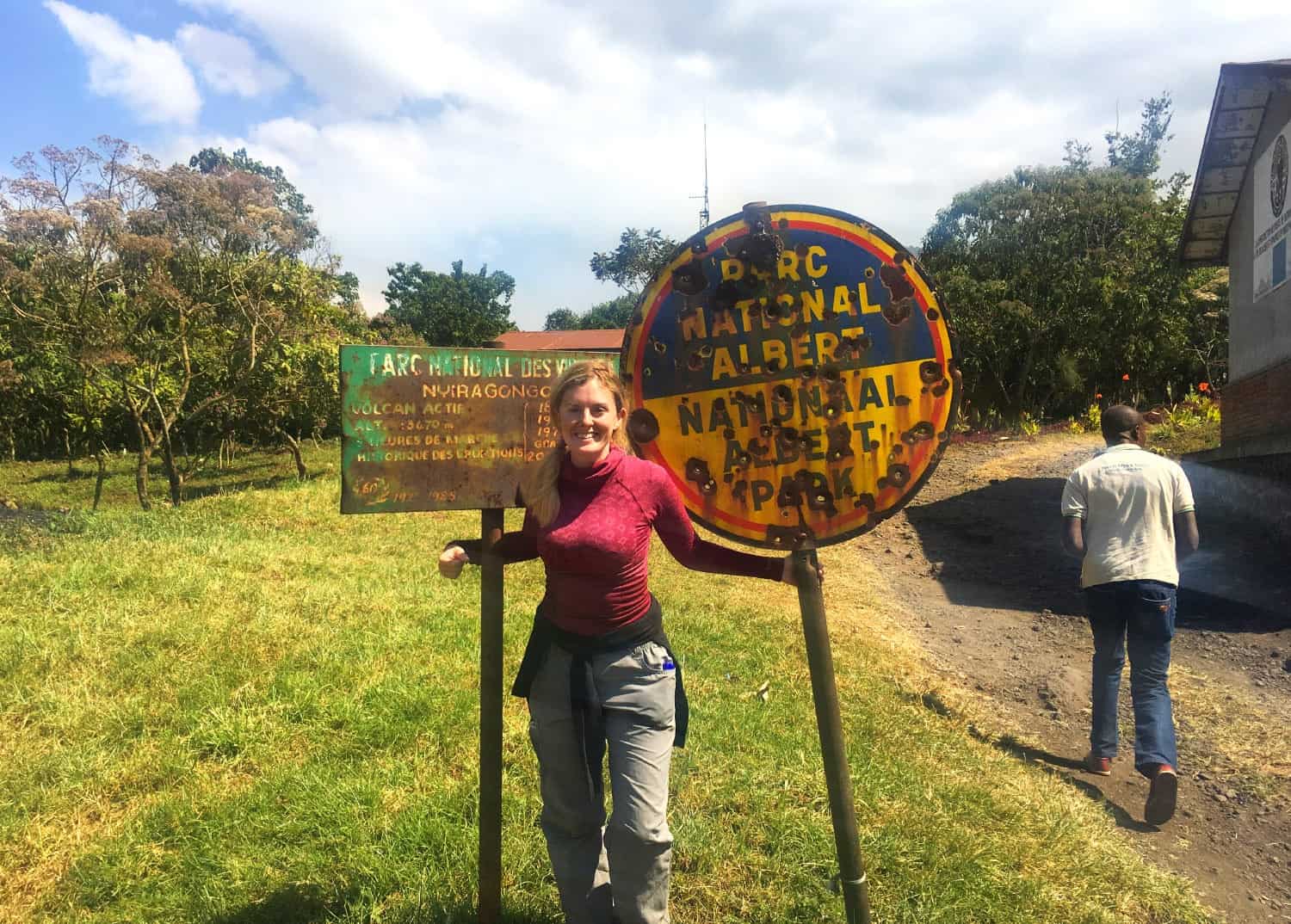
We reached the base of the volcano after a bumpy ride through the cool morning air, and began the mad rush of organising everything we needed to before my trek. I handed my permit to a member of staff in the office, found the luggage room to leave my backpack in, and peed in the worst toilet in the world. Side note: I’ve never had so many people unlike my Facebook page after posting a photo! Turns out people don’t like to hear about my urine pooling around my hiking boots.
Only mildly traumatised by the experience, it was time to meet my porter, cook, guides, and rangers. I paid $5 for a wooden walking pole, then we gathered in a huddle for our briefing.
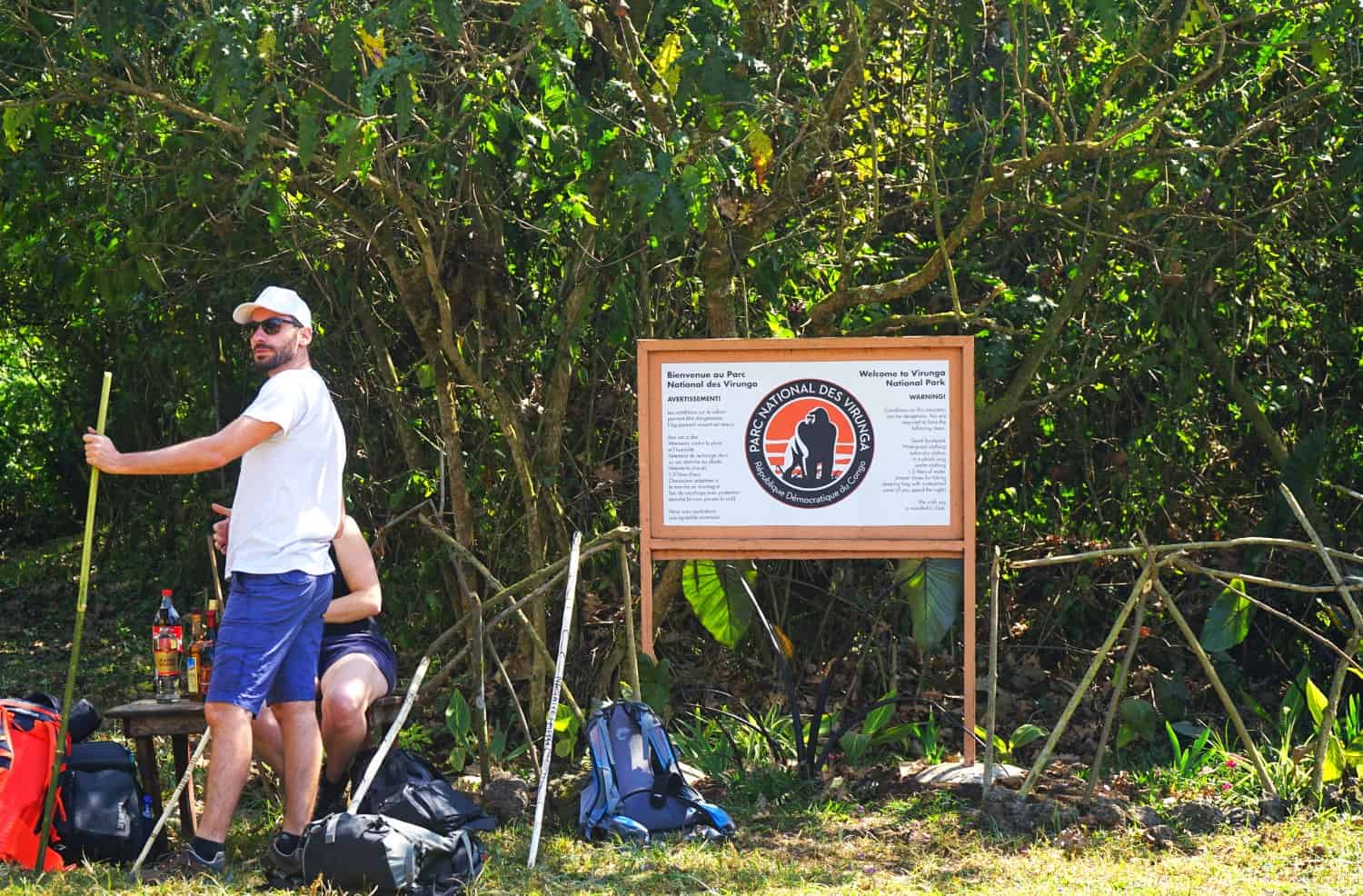
Before I had time to mentally prepare for the challenge that lay ahead of me, suddenly, we were walking, and I was waving my walking pole around because it turned out I had no idea what to do with it.
This first segment was a warm-up stage of the hike: just a 45-minute trek over reasonably flat ground in the jungle. This was the easiest section of the hike, although the fact that I found it surprisingly challenging didn’t bode well. The hike starts at 2,000 metres, which my body found hard to acclimate to.
This was a time to chat to the people in the group, to find out where we were all from and what the hell had brought us to the Congo to climb an active volcano.
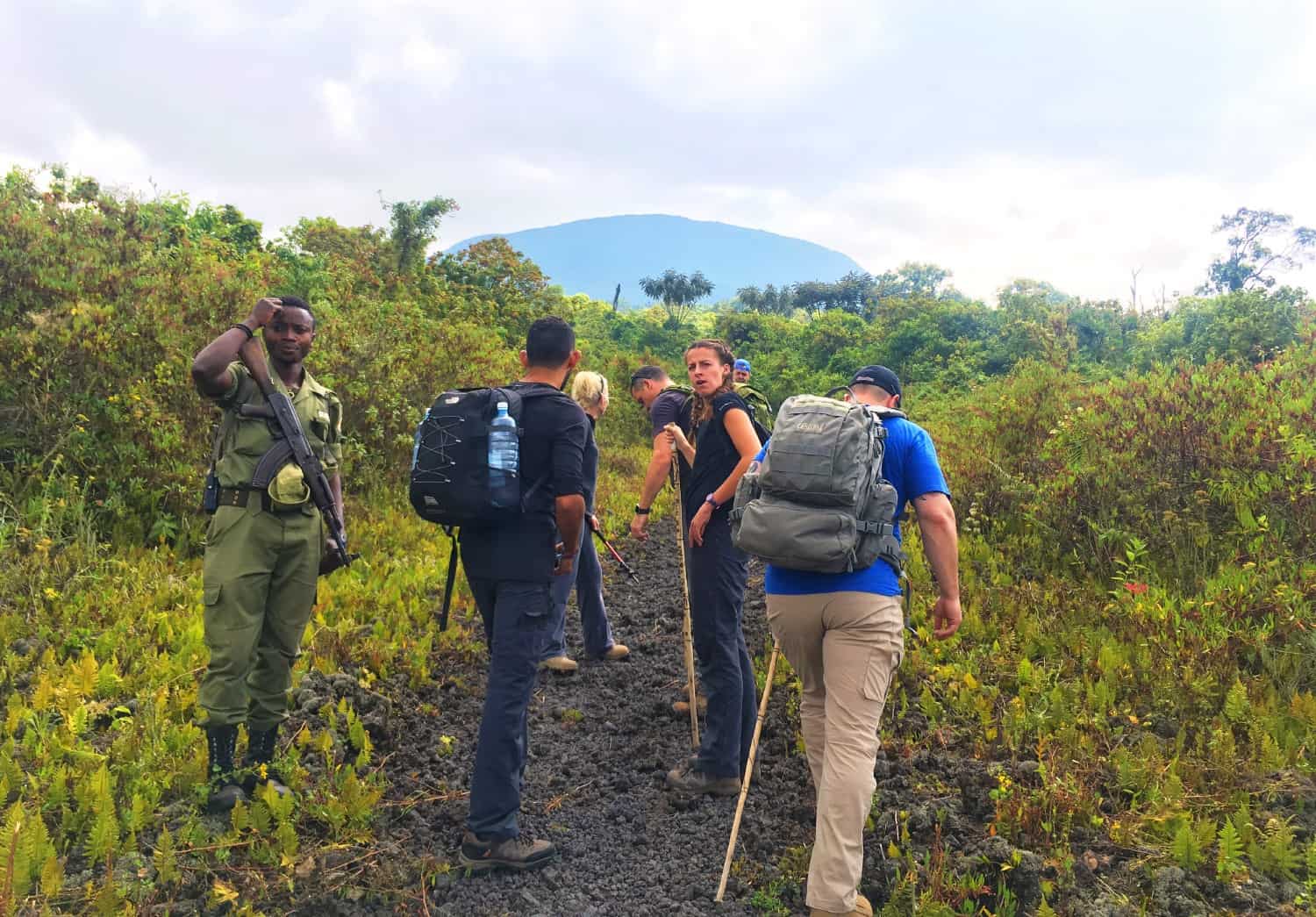
The second and third sections were my favourites.
I’d been training for the hike in Lisbon for months before I left, but the altitude was knocking me down and I didn’t have the energy to go fast. Because these rocks were loose and wobbly in these segments, we walked much slower, and I was able to make my way to the front of the pack. I love clambering over rocks, so on this part of the climb I was in my element.
At one point, we paused to stare into a fissure in the earth, sulphuric steam rising from the vents around us. Back in 2002, Nyiragongo had erupted from its flank, sending a two-metre-high wave of lava down into the city of Goma, and we were now standing where it had all began.
Our group was split into two here — faster and slower walkers, and while I felt as though I should go with the slow group, I knew my fitness levels were higher than I gave myself credit for. I’d trained hard for this and I’d been walking towards the front with few struggles up until this point.
I went with the fast group.
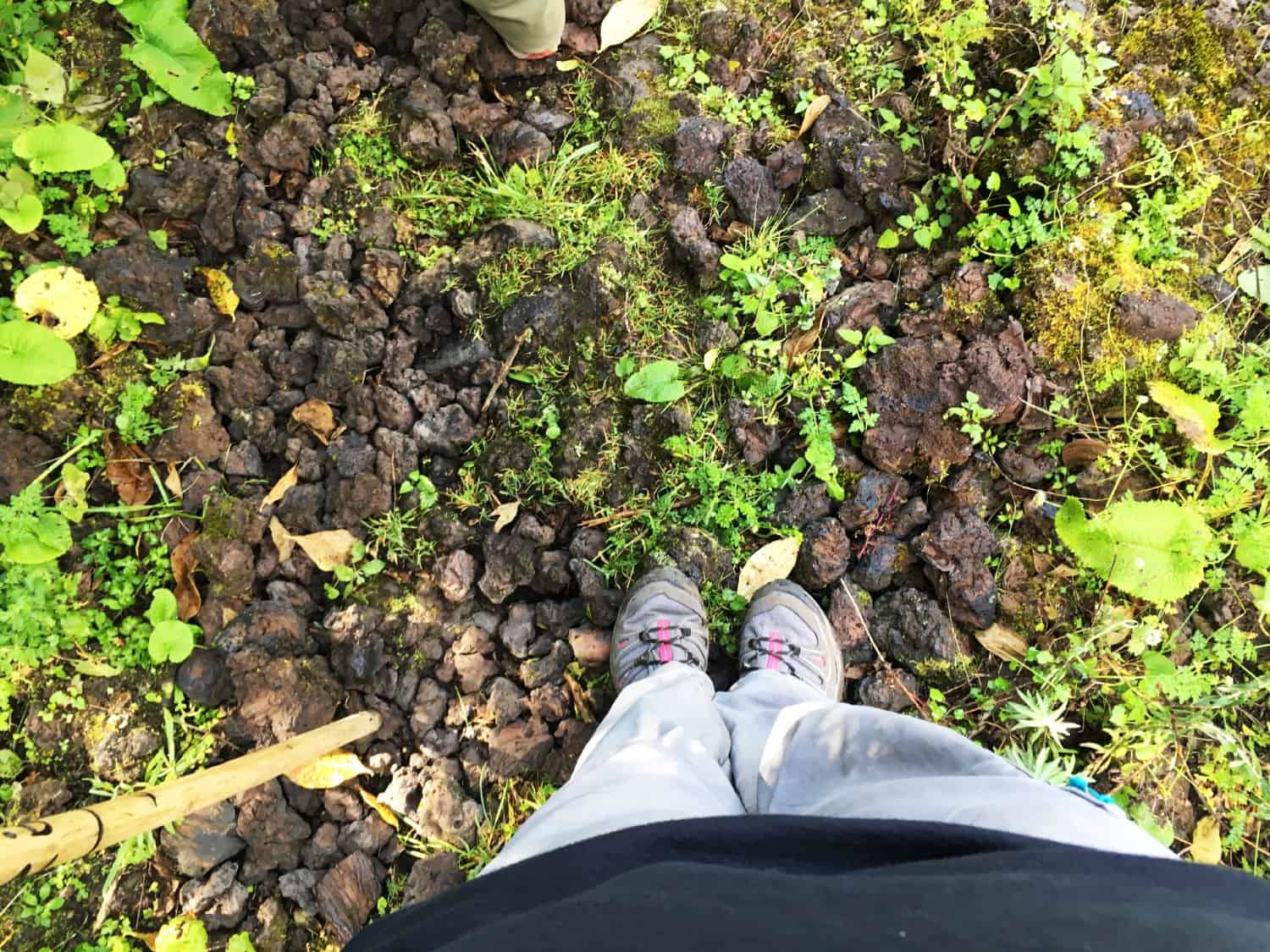
Immediately, I knew this was a tremendous mistake.
As the group picked up the pace from the steady trudge we’d been racking up previous to this, I was slowly overtaken until I’d fallen straight to the back.
This segment was a slog. It was the longest part of the hike, far steeper than the stages we’d encountered before. We were gaining altitude rapidly now, taking huge steps continually upwards with little time for rest. I watched in dismay as the rest of the group powered on ahead of me and out of sight.
My ranger became nervous at this development, urging me forwards, not wanting us to separate and leave anybody vulnerable.
I knew I was pushing myself too hard. The lava rocks were starting to blur into a sea of blackness, as I struggled to inhale enough oxygen. More than once, I considered telling the ranger I couldn’t do it and would need to descend.
Is this altitude sickness?
My lack of French kept me from announcing my hike was over, and when I spotted the final rest stop an hour later, I felt as though I could burst into tears of joy.
All I had left was a 30-minute hike to the summit and I knew I could make it.
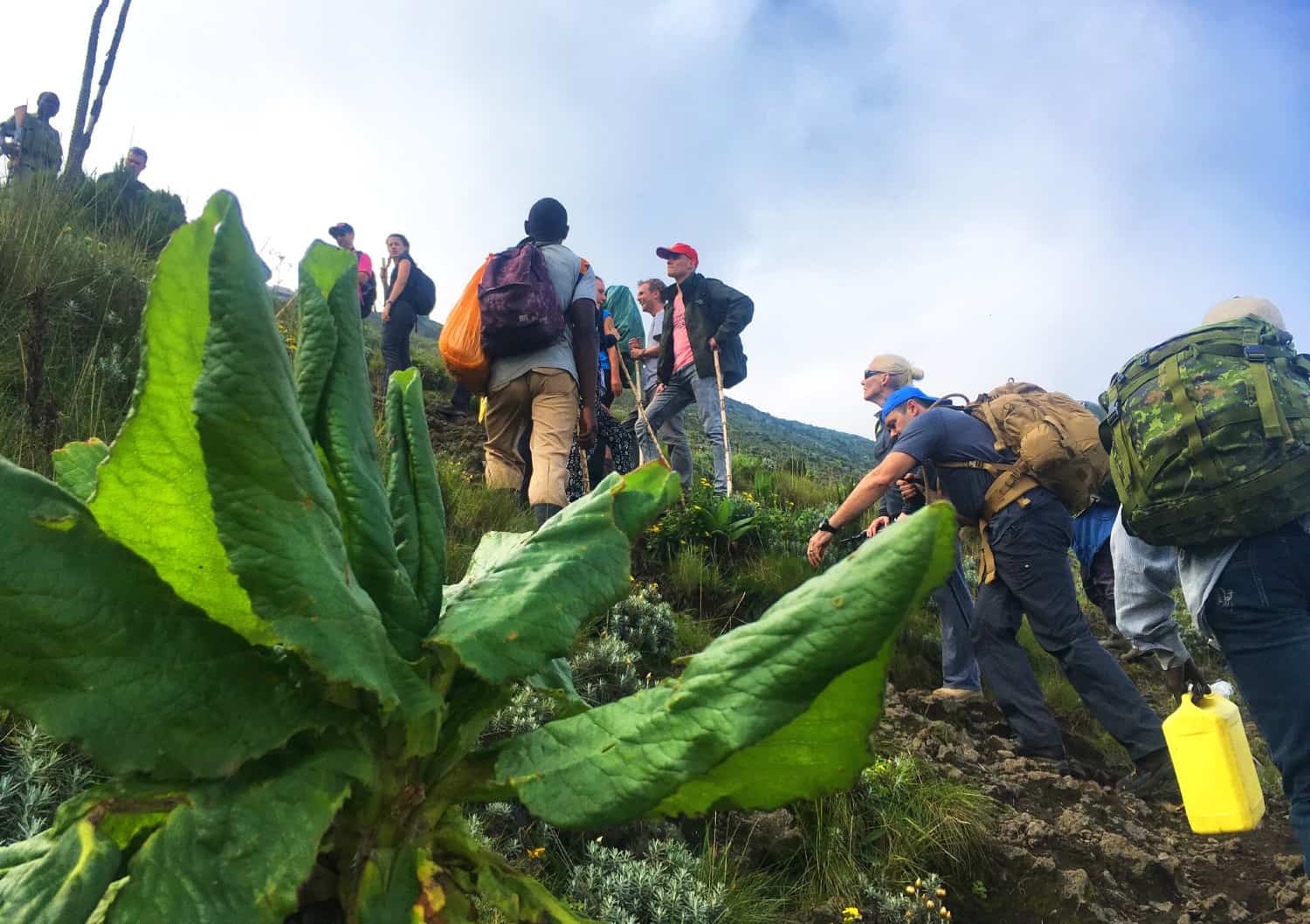
I’d read beforehand that the fifth segment is the toughest, but I wasn’t sure how anything could top the previous stage.
We all felt the altitude now, breathless at 11,000 feet high, an unbelievably steep climb stretching in front of us to the top.
There wasn’t much of a path to follow here. Just a side of a volcano to scale, choosing any route that made the most sense; none of them any easier than the other. Up we climbed, some of us on our hands and knees, all of us taking it slow and steady, the smell of sulphur now beginning to penetrate our nostrils.
We had been told by our guide that in a group as large as ours, it was exceptionally rare for everyone to make it to the top, so I was overjoyed to see nobody failed to reach the summit. Even the 72-year-old man from Singapore made it, which had me wondering just how active I would likely be in my 70s. What a badass.
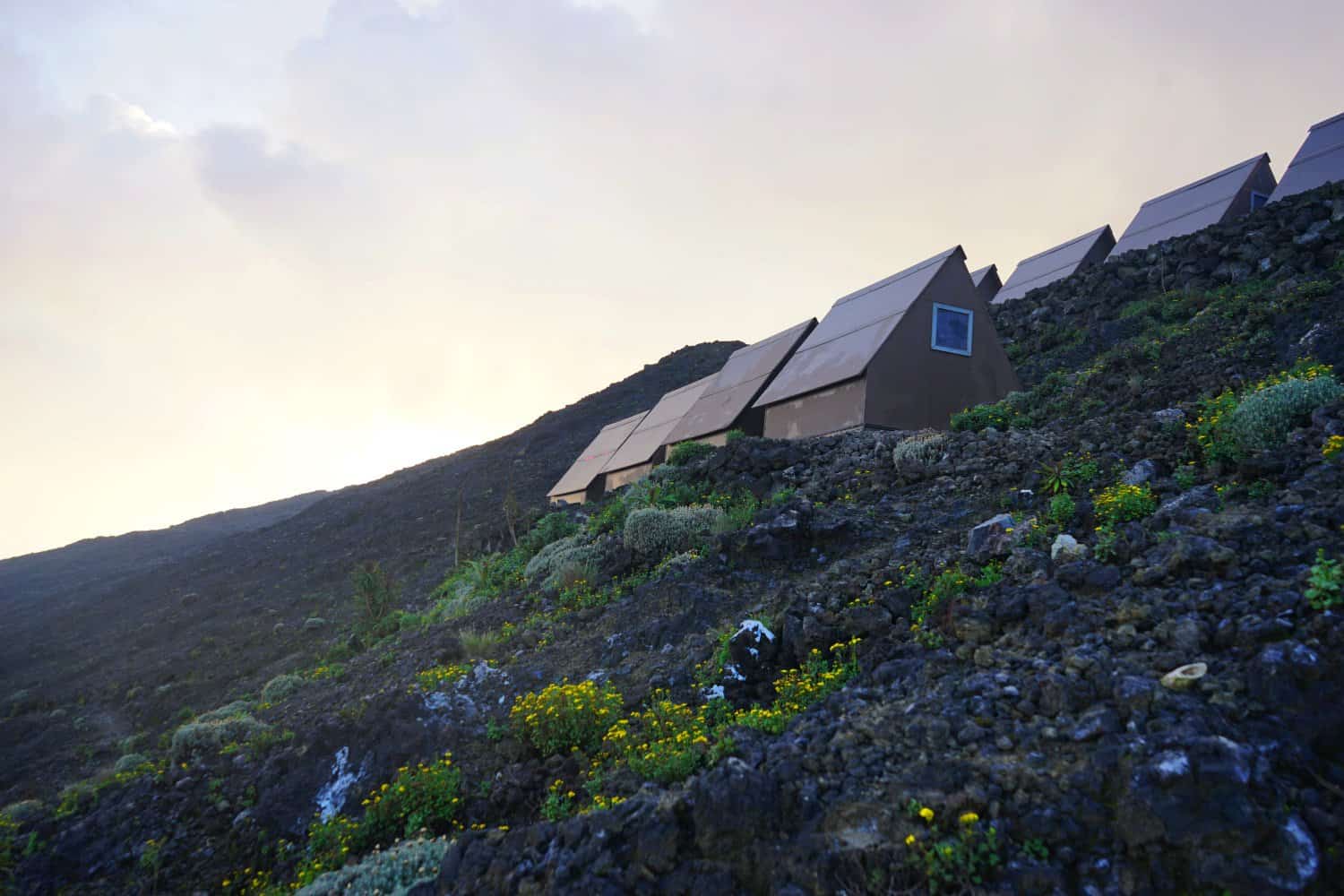
Multiple times during the climb, I’d wondered if the hike would be worth it.
I’d considered giving up more times than I could count, the prospect of being able to breathe properly far outweighing that of peering into the world’s largest lava lake. It was just a volcano — how special could it be?
But that first glimpse of lava will forever remain etched into my memory.
It was like staring into a photo. I’d spent so much time researching Nyiragongo that now that I was finally there, it didn’t feel real. I was so in awe that I had to keep blinking to prove to myself this wasn’t a dream.
One of the guides brought around hot cups of tea, which were gratefully sipped as we stared down into what felt like the gates of hell, all of us rendered speechless.
I sat down on a nearby rock, inhaling the fumes, watching the sun set, and thinking to myself that this was going to end up being one of the coolest things I ever do in my life.
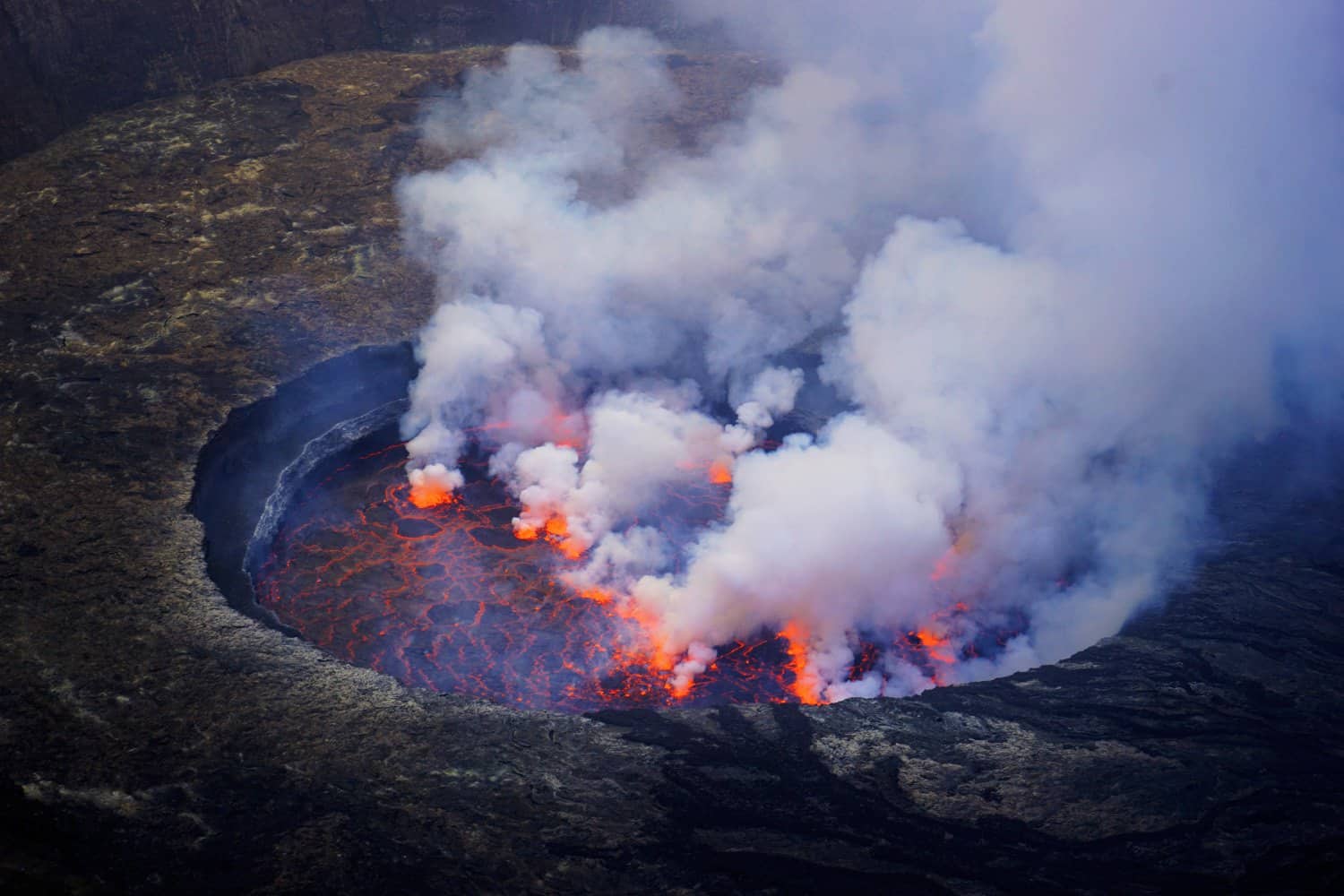
After my traumatising toilet experience at the start of the day, I was fully prepared for an awkward squat in the fresh air, but the outhouse at Nyiragongo had one of the best views from any toilet I’ve ever used.
There was even a toilet seat!
But still no door, which was still weird and nerve-wracking.
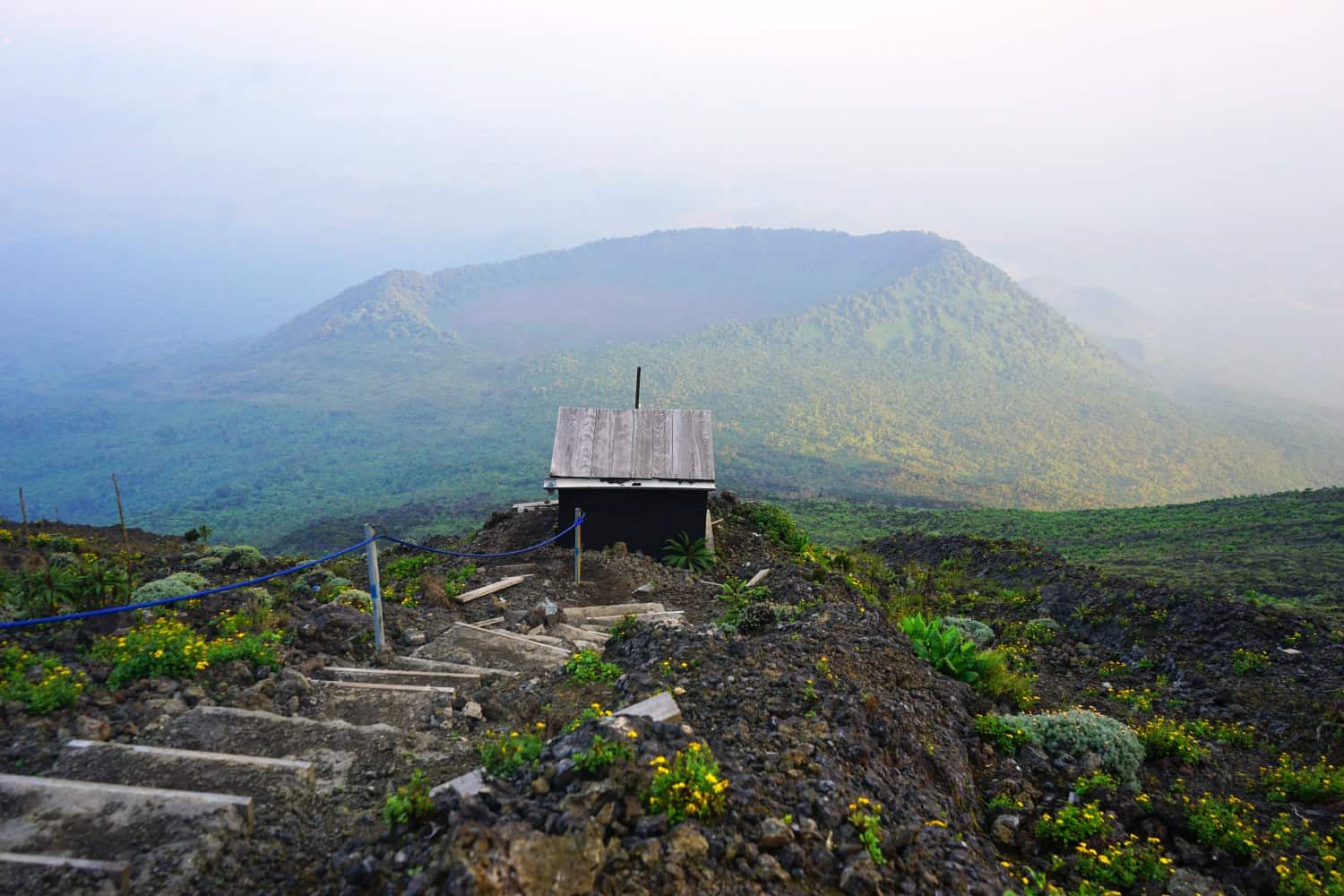
Virunga offers a meal package to hikers, where you can pay for a cook to climb the volcano with you, hand out snacks and drinks at rest stops, and then put together a three course meal in a toasty-warm cabin when you reach the top. The decision, for me, had been a no brainer, and from the moment I stepped inside the chef’s hut, I was glad I’d opted for it.
It was a surprisingly delicious meal for having been cooked on a single hot pan in the middle of a small cabin.
What I had yet to realise at this point was that being at altitude can seriously dampen your appetite. From the moment I finished my soup, I was struggling to eat the pasta and potatoes, and stomaching the dessert was near-impossible. Despite my struggling stomach, I ate as much as I could, aware that I’d be needing the energy tomorrow.
We spent over an hour in the cabin, relishing being somewhere so warm while everyone else was shivering outside in freezing temperatures.
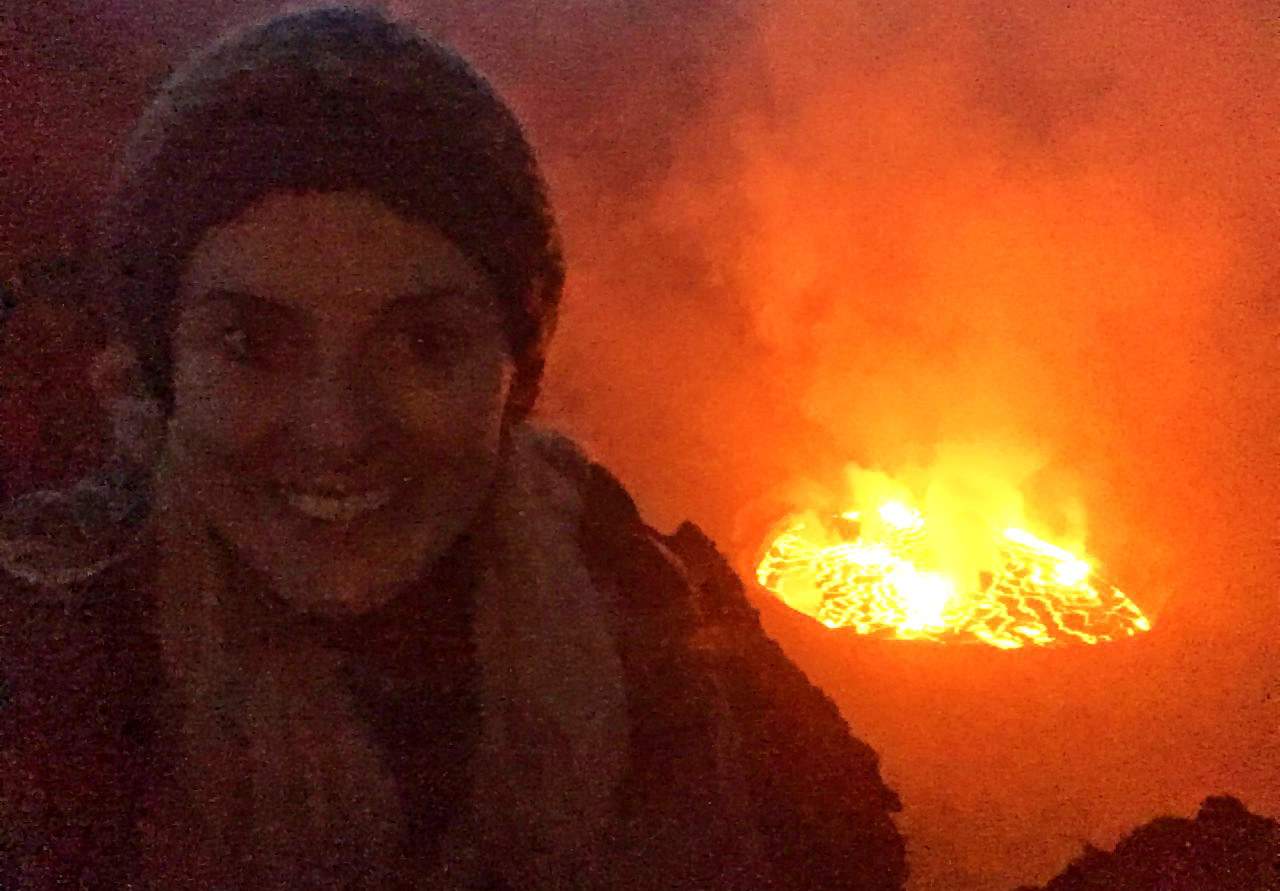
Afterwards, we bundled up and faced the bitter cold once more to take blurry photos of the lava lake now that darkness had finally fallen.
As we sat and drank hot cups of tea together, we discussed whether you’d feel any pain if you were to fall into a pool of lava or whether you’d be obliterated in an instant. We spoke about how this was one of the coolest things we’d ever seen, and shared stories of other volcanoes we’d climbed around the world; other mountains we’d summited. Kilimanjaro in 2023? Don’t be surprised if you see me tackling it.
Part of me considered sitting shivering up on the rim for the night, watching the lava crash like ocean waves against the crater floor. Part of me knew I’d regret not making the most of my time in such a special place, but I also knew I’d have a long and difficult climb back down the following morning, and I needed to get some rest.
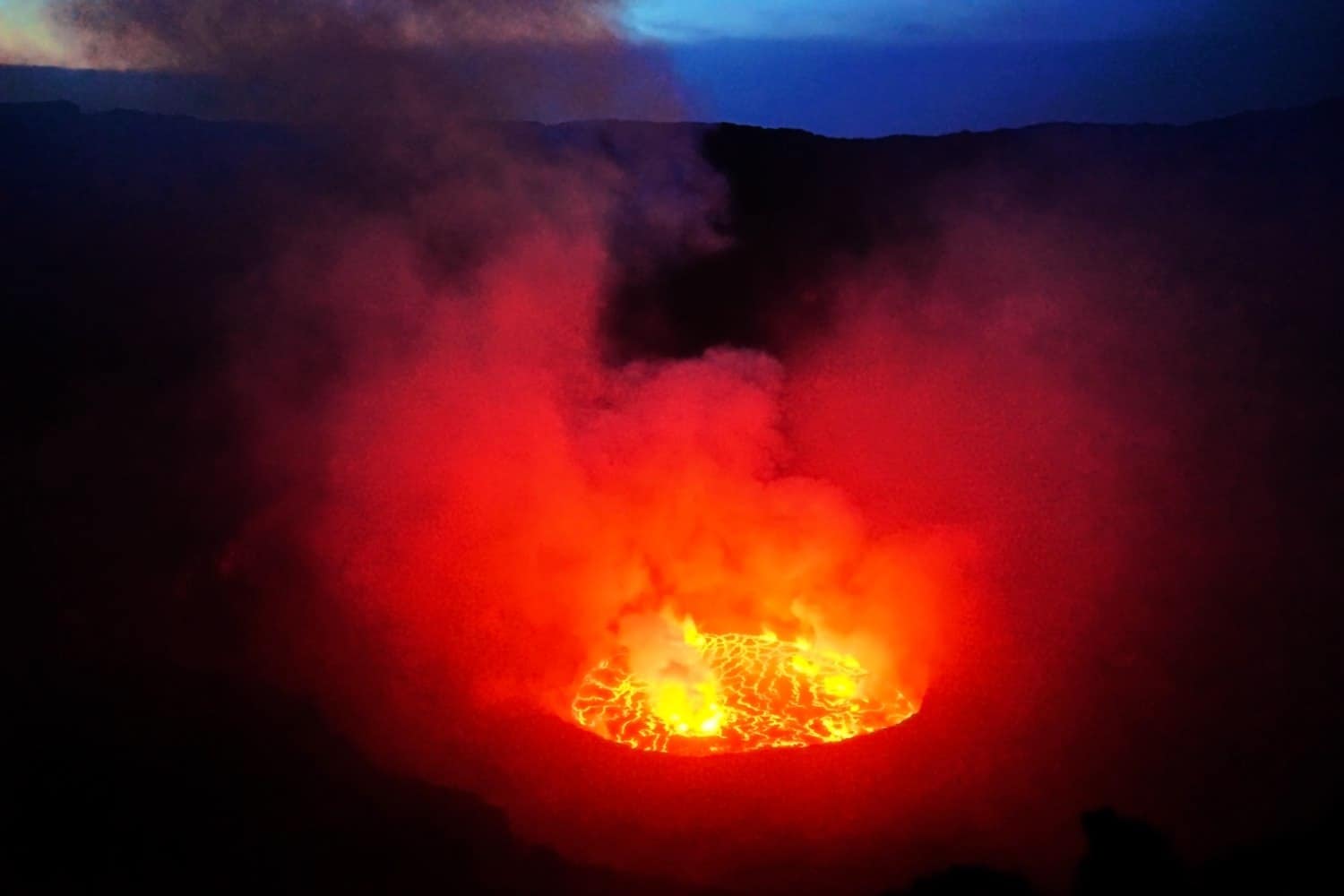
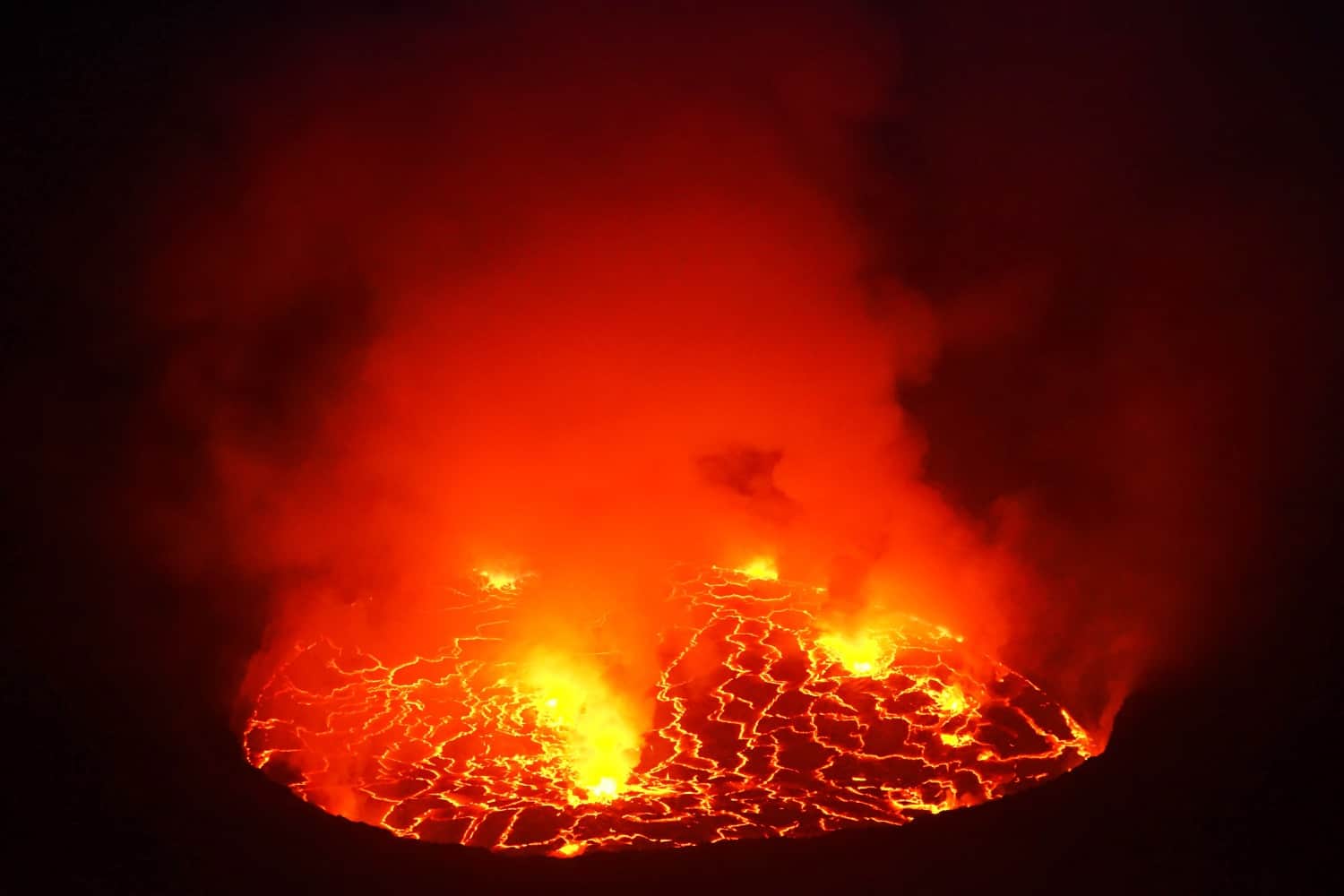
Sleep was hard to come by, and I tossed and turned for hours in my poorly-insulated cabin. The mattresses were more like gym mats, made from a material that had zero ability to hold any heat. Without anything to use as a pillow, it was like resting your face against a window in the middle of winter for hours on end.
I’d taken Diamox to prevent altitude sickness, and the tingling side effects were in full force: my entire face had pins and needles. It was in my tongue, my lips, my eyeballs, and all over my hands and feet. Diamox acts as a diuretic, too, so in addition to my paresthesia, I was creeping outside every hour to urinate over lava rocks.
While the outhouse is accessible during daylight hours, attempting the descent after nightfall would have been treacherous, even with a headlamp. Instead, I’d crouch over on the rocks beside the cabin, listening to the lava bubbling and splashing beside me as a thousand twinkling stars illuminated my skin to anyone else who was emptying their bladder at the same time.
Attempt to sleep — creep back outside — attempt to sleep — creep back outside — and so on and so on until 5 a.m. rolled around and it was time to get our day started.
We were served breakfast in the chef’s hut: a hearty meal of fruit and meat and cheese and yoghurt, but still my appetite was shot from the altitude, so I could barely eat a thing.
I met back up with my friends and learned that one of them had been throwing up all night long. We concluded it was either food poisoning or the altitude, hoping it was the latter because we were about to rapidly reach lower ground.
We packed our backpacks, grabbed our walking poles, and psyched ourselves up for the descent.
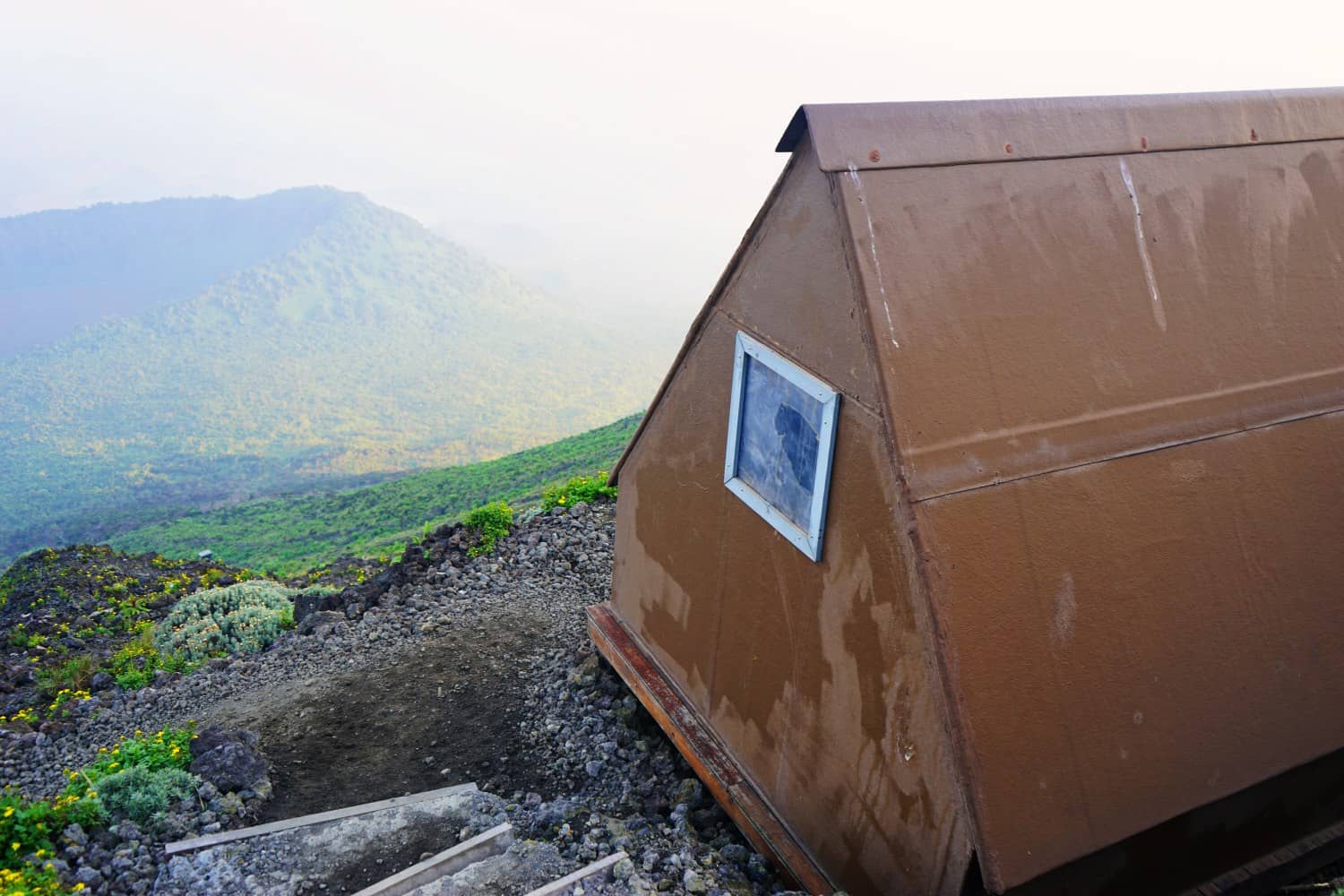
If I’d found the ascent tough, I knew it would having nothing on today’s adventure. Reports online had varied: some people made their way to the bottom in half the time of their ascent; others took twice as long to make their way down. I knew I was going to struggle to stay upright regardless of how long it took me.
The first section would likely be the toughest of the day. It was the steepest part of the hike and consisted of loose lava rocks that fell away as soon as you attempted to transfer any weight to them.
Taking a deep breath, I hovered a tentative foot down, windmilling my arms in wide circles as I tested every rock with my toes. There was little way of knowing which ones would tumble away until it was too late and you were tumbling down with them. I had no confidence.
Within a few minutes, my porter rushed down the volcano towards me and held a hand in my direction.
“Thank you!” I gushed, as he smiled shyly up at me.
Together we walked, him tightly gripping my hand and pointing to where my feet should go, me generally flailing around and feeling like this was far harder than attempting to stand upright when surfing.
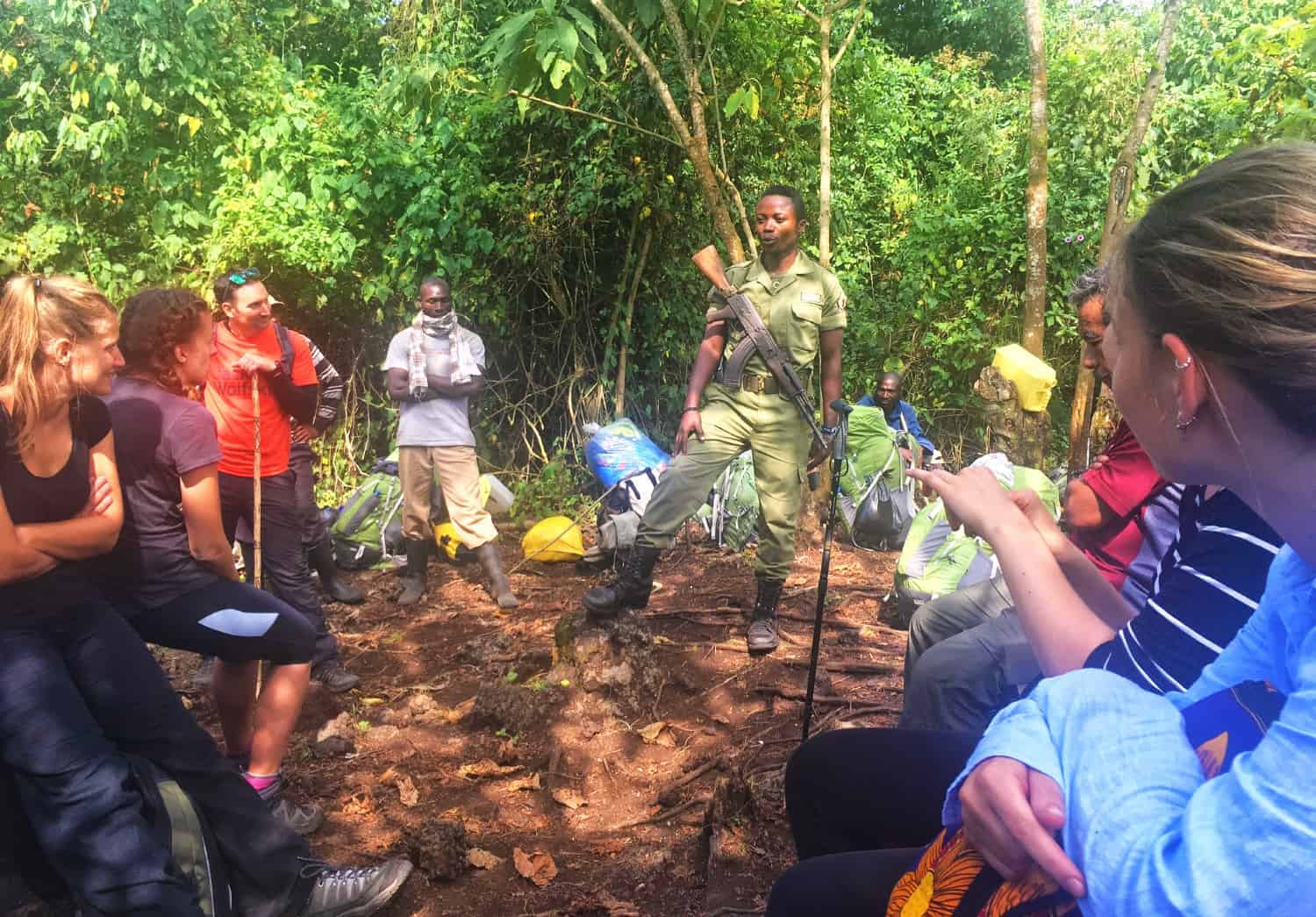
I’d love to tell you all about how I found my footing eventually, but that would be a lie.
I was quite literally all over the place as we made our way over the scree. Of our group of 24, just one other girl and I were the only flailers who needed continual help from our porters.
Section four was just as relentless on the way down, and two and three would have been nerve-wracking if I hadn’t had someone showing me where to place my feet.
I couldn’t have done it alone.
Every step I took had me on the verge of falling down, and if I hadn’t had my porter by my side, I would have had to slide the entire whole way down on my ass.
It was either that or risk a broken ankle.
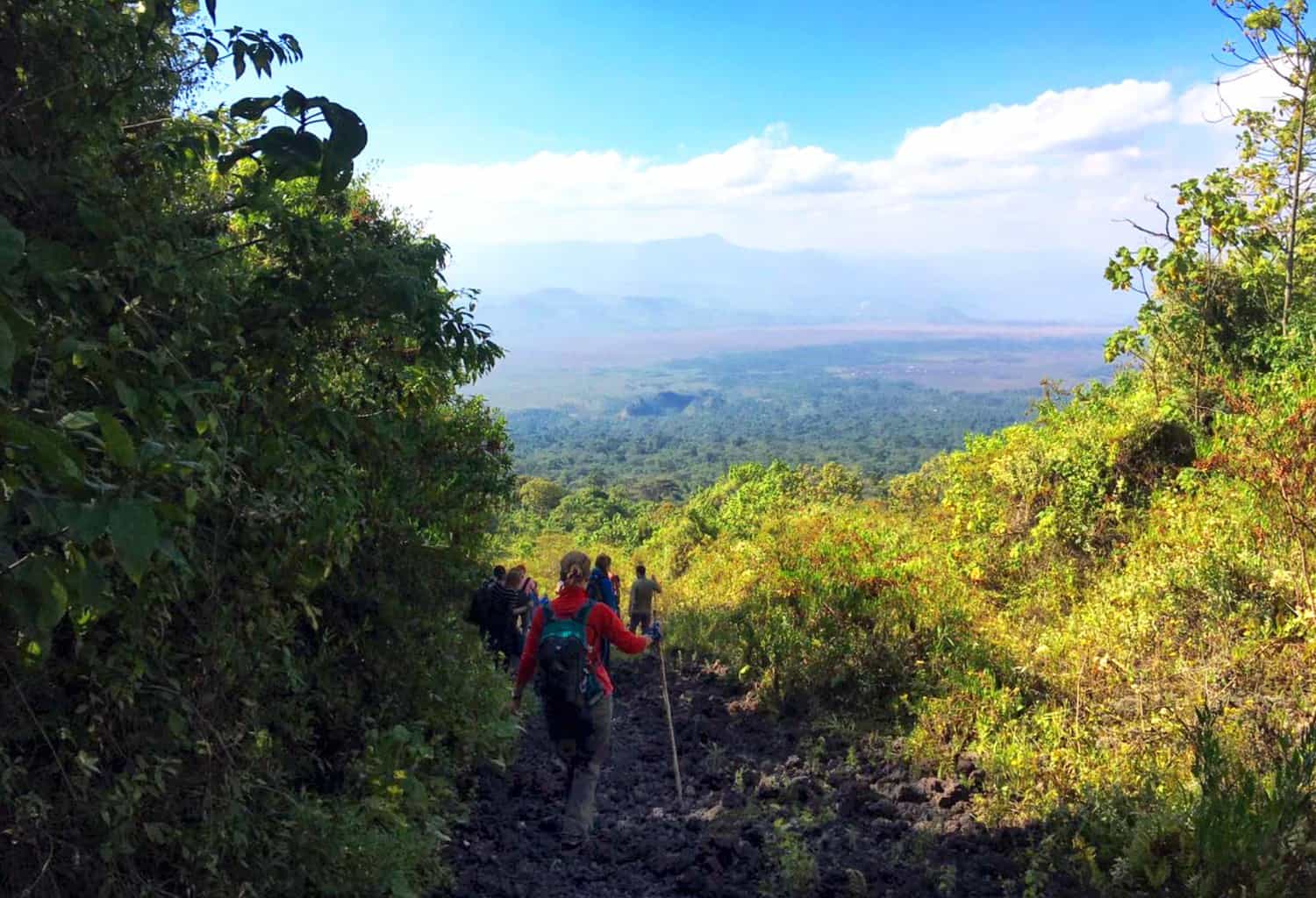
Words can’t describe how glorious it felt as we approached our final rest stop and knew we just had one segment left to walk.
Less than an hour remained until my legs would be free and I could finally take a shower. As we began our trek over the flattest section of the walk, I began to wave my hiking stick in the air with abandon, galloping towards the finish line with only a slight tremble in my knees. I had made it, I realised, and I couldn’t keep the grin from spreading across my face.
At the end of our trek, chaos reigned supreme, as we all rushed around in an attempt to tip every ranger, exchange contact details, find our transportation, and locate our luggage. I handed out my spare cash, spotted the Virunga truck that was waiting for me, and began to say my goodbyes. Some people were heading back to Goma, some to the Rwanda border, and then there was me, who still wasn’t done with the DRC yet.
After taking some last minute photos, I grabbed my backpack, clambered up into the truck, and turned to wave a sad goodbye to my friends.
And thus concluded the most incredible experience of my life.
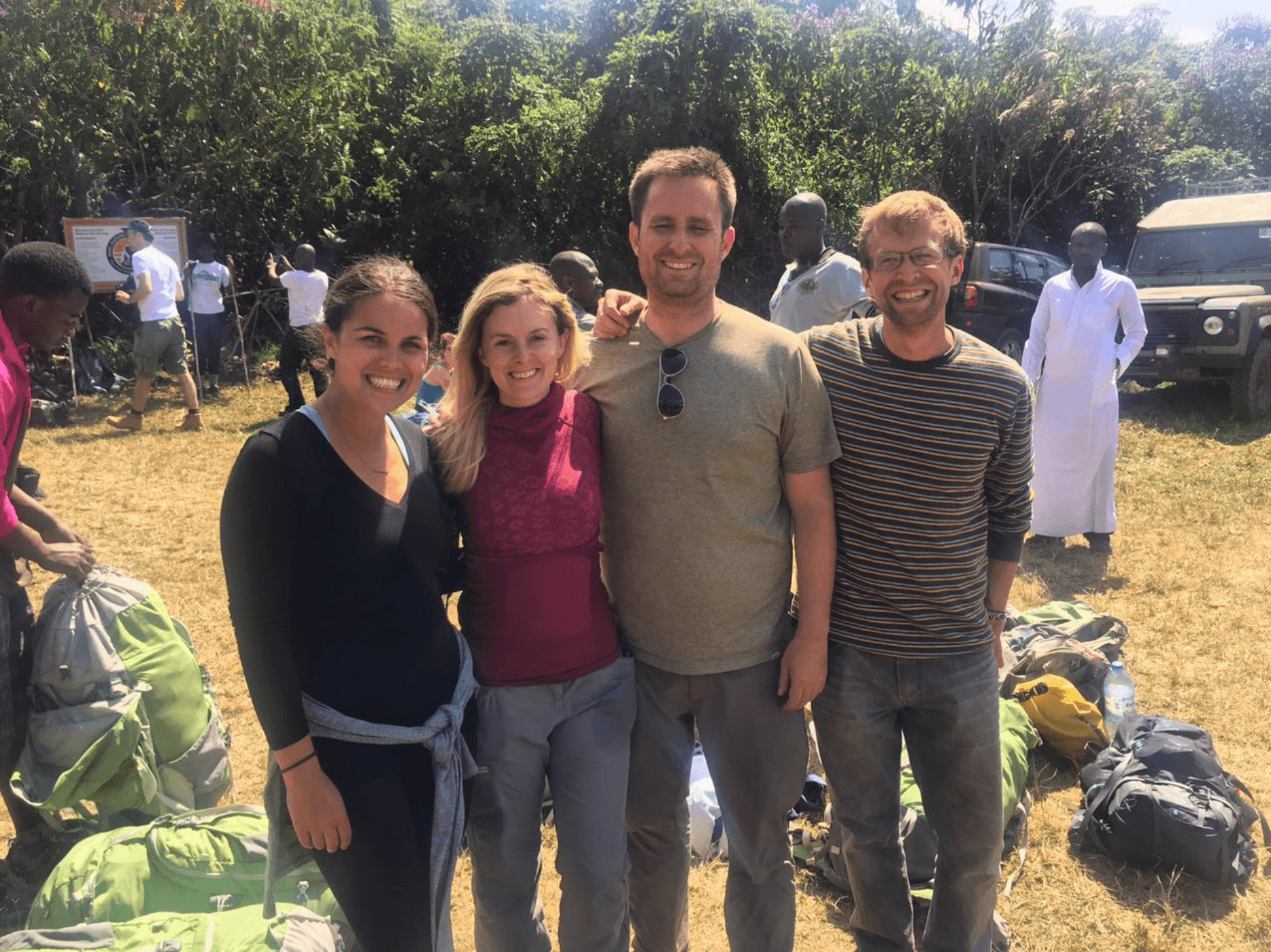
What to Know Before You Climb
It’s 5,000 times colder at the summit than you think. Trust me: take twice as many warm clothes as you think you’ll need. Everyone in my group was freezing all night.
Don’t bother with a tour. It sounds unbelievable, but my time in the DRC was one of the easiest trips I’ve ever taken. I know it sounds intimidating, but once you’re there, it’s anything but. Booking through Virunga’s website is quick and straightforward, you’ll have someone from the park meet you at the border and stay with you at all times, and there’s no need to worry about anything. Because you can only do the hike through Virunga National Park, you’re literally just paying a tour company more money to have the exact same experience.
The trek is tough but doable. It took us five hours to reach the summit and three to get back down again. Some groups make it up in as little as four hours; some take 12 and get there after nightfall. This is a hard hike. There are no switchbacks, so you’re walking straight up a volcano with very little rest. It was easily the hardest physical challenge I’ve ever set myself. But don’t let that put you off: if you can walk around 15 miles on flat ground without stopping, you should have a high enough fitness level to make it to the top.
It’s an affordable way to sample travel in the DRC. The Congo is one of the ten most dangerous countries in the world, so traveling extensively there isn’t an option unless you want to die. Climbing Nyiragongo is a pretty safe way to spend 24 hours in the country while doing something badass at the same time.
Know that you run the risk of seeing nothing: You can’t predict the weather and we ended up being fortunate on our trip. The night before, it had been so cloudy that the guys at the top didn’t even get to catch a glimpse of the lava while they were there. We had completely clear skies for the entire time we were at the top. Unfortunately, you do run the risk of hiking all the way to the top of the volcano and seeing absolutely nothing when you get there. Nature!
It’s worth paying for extras. I don’t know how I would have managed without my amazing porter, so I highly recommend spending the $24 to hire one. On top of that, you can pay $5 for a wooden walking pole, which was more than worth it on the descent. Finally, you can shell out $100 for a gear + meal package. While this isn’t essential, not having to pack a sleeping bag, or attempt to prepare dinner and breakfast for myself on top of a volcano, was a huge bonus.
Diamox is a good idea. Unless you’ve spent time above 3,500 metres (around the altitude of Cusco, Peru) and know you aren’t prone to altitude sickness, it’s wise to stock up on Diamox (altitude sickness preventative) and take it on the hike. One of my friends had symptoms of altitude sickness and spent the entire night throwing up on the side of the volcano.
You can leave your luggage behind. Maybe it’s just me being a worrier, but I was so concerned about what to do with my luggage on the hike. The good news is that there’s a luggage room you can store your bags in while you’re hiking. I bought the gear package from Virunga, which came with a fully-stocked backpack, so that’s what I had my porter carry to the top; I left my backpack in the storage area.
Don’t read the news before you arrive. Here’s what you need to know about the safety situation in the DRC: if tourists are likely to be in any danger, Virunga closes the entire park and doesn’t let anyone enter. It makes sense — if something was to happen to a tourist there, they’d suffer enormous losses. Because of this, I recommend that you don’t, don’t, don’t read any news about the DRC before you arrive, because all you’ll do is scare yourself. In the two weeks before I arrived, there were news reports on how hundreds of locals — and two UN workers — had been discovered in mass graves, massive prison breakouts of militia members, a shelling of a school, a resurgence of Ebola, and so much more. It’s better to be ignorant and know that if you were in any real danger, you wouldn’t be allowed into the park.
Don’t get too close to the edge. There are no barriers at the summit of Nyiragongo, and it’s all too easy to slip and fall. A few years ago, a Chinese woman died when she tumbled into the crater. One of our guides even witnessed it and told a fairly gruesome story about the entire experience. Needless to say, be very careful and don’t get too close to the edge — not even for the ‘gram.
Don’t bother attempting to fly a drone over the volcano. Our guides referred to the volcano as a drone graveyard because there were dozens of broken ones littered all over the summit. It has something to do with the ash in the air affecting how they fly.
Avoid weekends if you want a smaller group. Weekends are the busiest times to hike, because the UN and NGO workers in Goma often sign up to climb on Saturdays. We had a group of around 24 on the Saturday I chose, but a normal number is more like 6 or 8. Even though I usually like small groups, we had such a wonderful bunch of people on our hike that I was happy we had so many people to cheer each other on.
Tip your porter, cook, rangers, and guides. Bring extra cash with you to tip everyone when you finish hiking. These guys risk their lives every day to take tourists all over Virunga, so you’ll definitely want to show your appreciation. I tipped my porter $50 (this was probably 5 times more than he was expecting!), and the cook, rangers, and guides $10 each.
Get travel insurance. Yes, you need it — don’t be stupid. Arrange travel insurance way in advance for your trip, and expect to struggle to find a provider to cover you, because it’s a riskier destination than most. Battleface is a good option if you’re coming up with nothing, as they’ll insure pretty much anyone for any trip ever. But I recommend SafetyWing, who are affordable and cover visitors to the D.R.C. You’ll pay $1.50 a day for coverage from them.
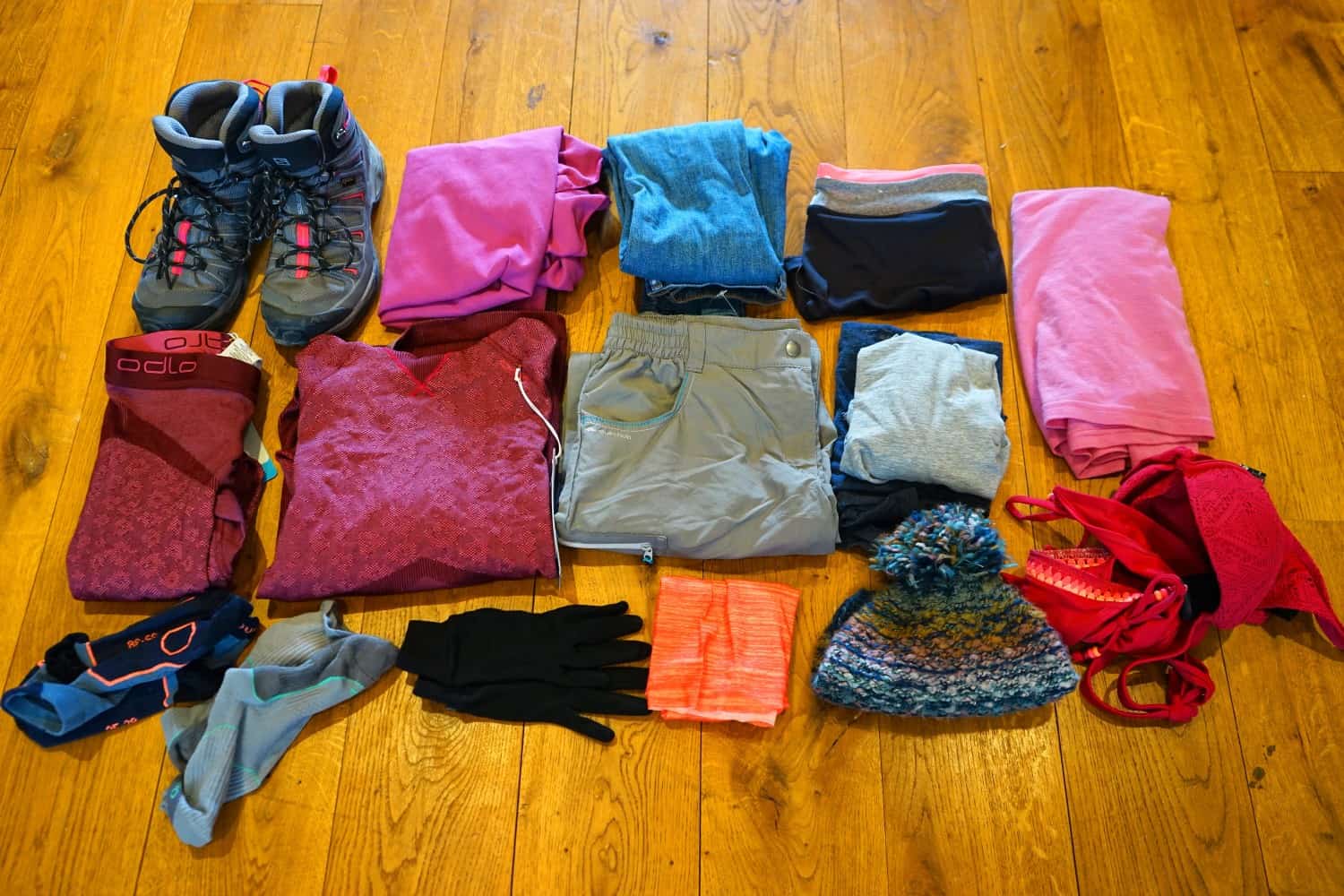
What to Pack for Hiking Mount Nyiragongo
Decent hiking boots that are water-resistant: Rain is common when you’re at the summit, so you’ll want to look for hiking boots that are water-resistant in order to keep your feet as dry as possible. Make sure to break in your boots before you arrive to ensure they’re comfortable when climbing up and down the volcano. I wore the Salomon X Ultra Mid 2 GTXs, and had zero problems with them on this specific hike — they were warm, comfortable, waterproof, and didn’t give me blisters or sore feet.
Multiple pairs of socks: They’ll keep your feet warm and wearing two pairs will help prevent blisters when hiking. I recommend getting a pair made from Merino Wool, as they’ll be super soft, and keep your feet cool when you’re sweating and warm when you’re cold.
Waterproof hiking pants: The weather can change rapidly and it’s more common than rare to encounter rain, or even hail, on the top of Mount Nyiragongo. Waterproof hiking pants are a good idea for keeping yourself warm and dry, which is important, as people have been known to get hypothermia when not properly dressed at the summit.
So many thermal clothes: If you opt for the gear pack from Virunga, you’ll have a fleece and rain jacket in your pack already, but I recommend taking several extras, too. I wore thermal leggings beneath my hiking pants, and on my top half, I had a thermal base layer, a thermal sweater, two fleeces, and a rain jacket. I was still cold when walking around outside!
A hat, a pair of gloves, and a scarf: I know. You totally think this is overkill now, but I promise you’ll be so glad you packed these. When it’s almost freezing outside, there’s a strong wind, and you’re sleeping in a cabin with holes in the walls, you’ll be grateful for any additional warmth you can get.
A headlamp to wear at night: One of the best ways to prevent or treat altitude sickness is to stay hydrated, and if you decide to take Diamox, you’ll be peeing regardless, as it’s a diuretic. Expect to spend much of the night tag-teaming your cabinmate as you each head into the freezing cold air to relieve yourselves. A headlamp makes this an awful lot easier, especially if you’re going to be stumbling over loose lava rocks on your way to the outhouse.
A dry bag: It’s definitely worth getting a dry bag and keeping your change of warm clothes inside, as well as your camera and anything else that’s important to you. That way, if it rains, you won’t have to put on wet clothes. I’ve been traveling with this 13l Sea to Summit dry bag for five years and counting — I love that it’s strong, lightweight, and yet to let me down in watery situations.
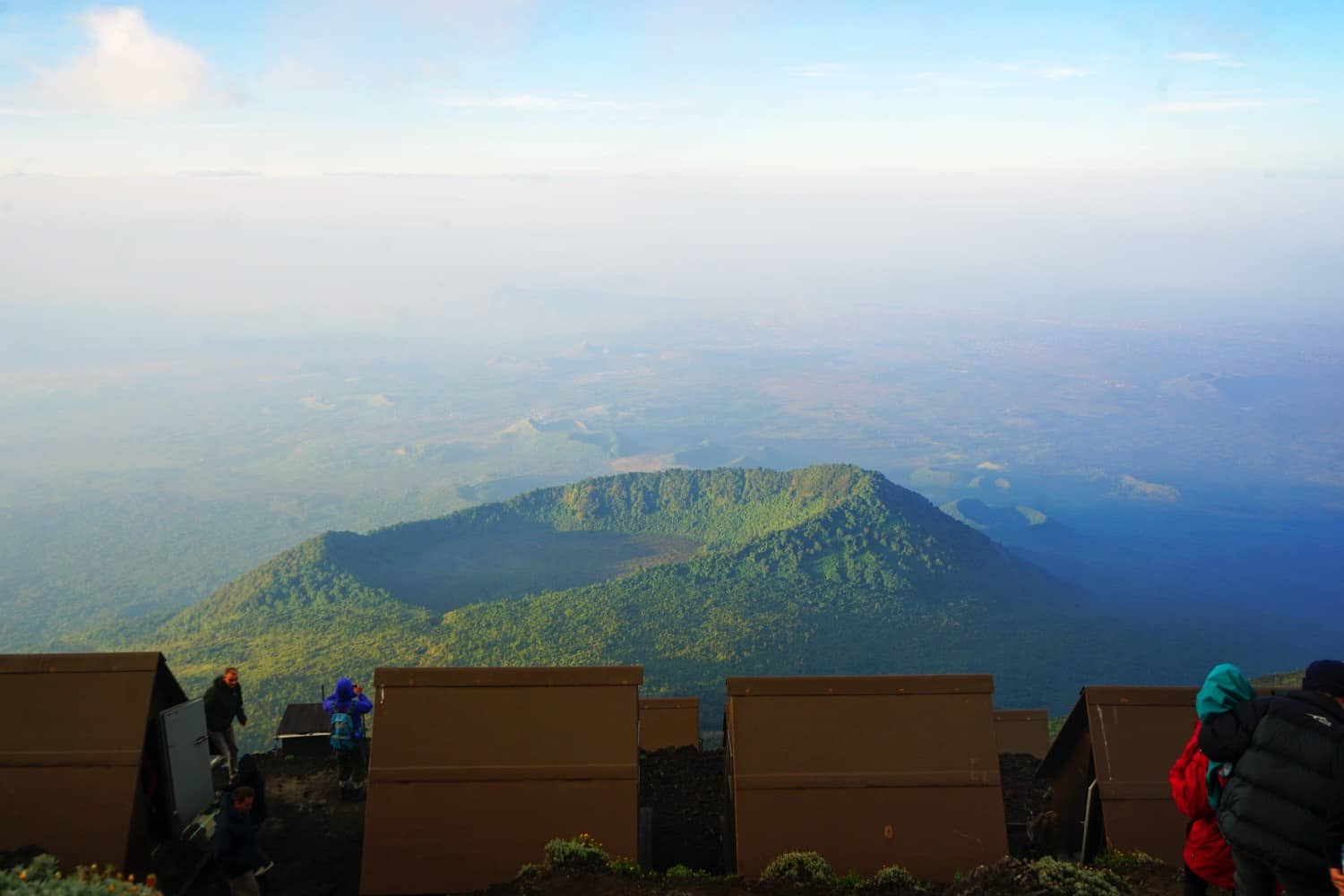
How to Get to Virunga National Park/The Democratic Republic of the Congo
If you’re sensible, you’ll arrange to get your visa for the DRC through Virunga National Park. You can do it all online once you’ve bought your permit, and it’s a seamless process from start to finish. My visa was approved within 48 hours and required no paperwork.
With this visa, however, you can only enter the country through the Grand Barrière border crossing between Gisenyi in Rwanda and Goma in the DRC. There are two border crossings in Gisenyi, so make sure you’re at the right one before you leave the country.
You’ll most likely fly into Kigali and then travel to Gisenyi via private car or public transport. The former is usually $100 each way, and the bus is around $15 to Gisenyi, then you’ll need to take a mototaxi for less than a dollar. It takes four hours to get from Kigali to Gisenyi — although the distance is short, the roads are winding, so driving is slow going.
The border crossing was incredibly easy, and no different to any other overland crossing I’ve done. Get stamped out of Rwanda, show your yellow fever card (you need this in order to enter the country), get your temperature checked, and then get stamped into the DRC. The entire process took five minutes. If you encounter any problems when crossing the border (or anywhere else in the park), you can call Vianney on +243 99 1715401 for assistance, so it’s worth making sure you can make phone calls within the DRC before you travel there.

How to Climb Mount Nyiragongo on a Budget
Hiking Mount Nyiragongo is easier to do on a budget than trekking with mountain gorillas (although you should try to do both on your trip), because you don’t need to stay in the DRC the night before your climb. Virunga National Park can pick you up at the border and take you straight to the starting point of the hike on the very same morning. Gisenyi, on the other side of the border has rooms starting from $11 a night, whereas you’ll be looking at a minimum of $40 if you decide to spend the night in Goma, in the DRC. Once you’ve descended the volcano, you can then travel back over the border to Rwanda and cheaper accommodation.
Permits to climb Nyiragongo are $300 through Virunga National Park, and this price includes accommodation in the cabins at the top.
I personally recommend spending an extra $24 to hire a porter to carry your backpack to the top, because hiking for five hours with 10+kg on your back at altitude will only end up breaking you.
I’d also recommend spending the $100 to get the gear + meal package. The package includes a warm sleeping bag and liner, a rain jacket, and a fleece, and you also get snacks, 5 litres of water, and a delicious three-course meal cooked for you in a warm hut at the top. Let’s just say that anyone who didn’t splurge on the gear package was pretty jealous of our feast at the top.
If you’re on a tight budget and super-athletic, however, you can skip those extras and just pay for the permit.
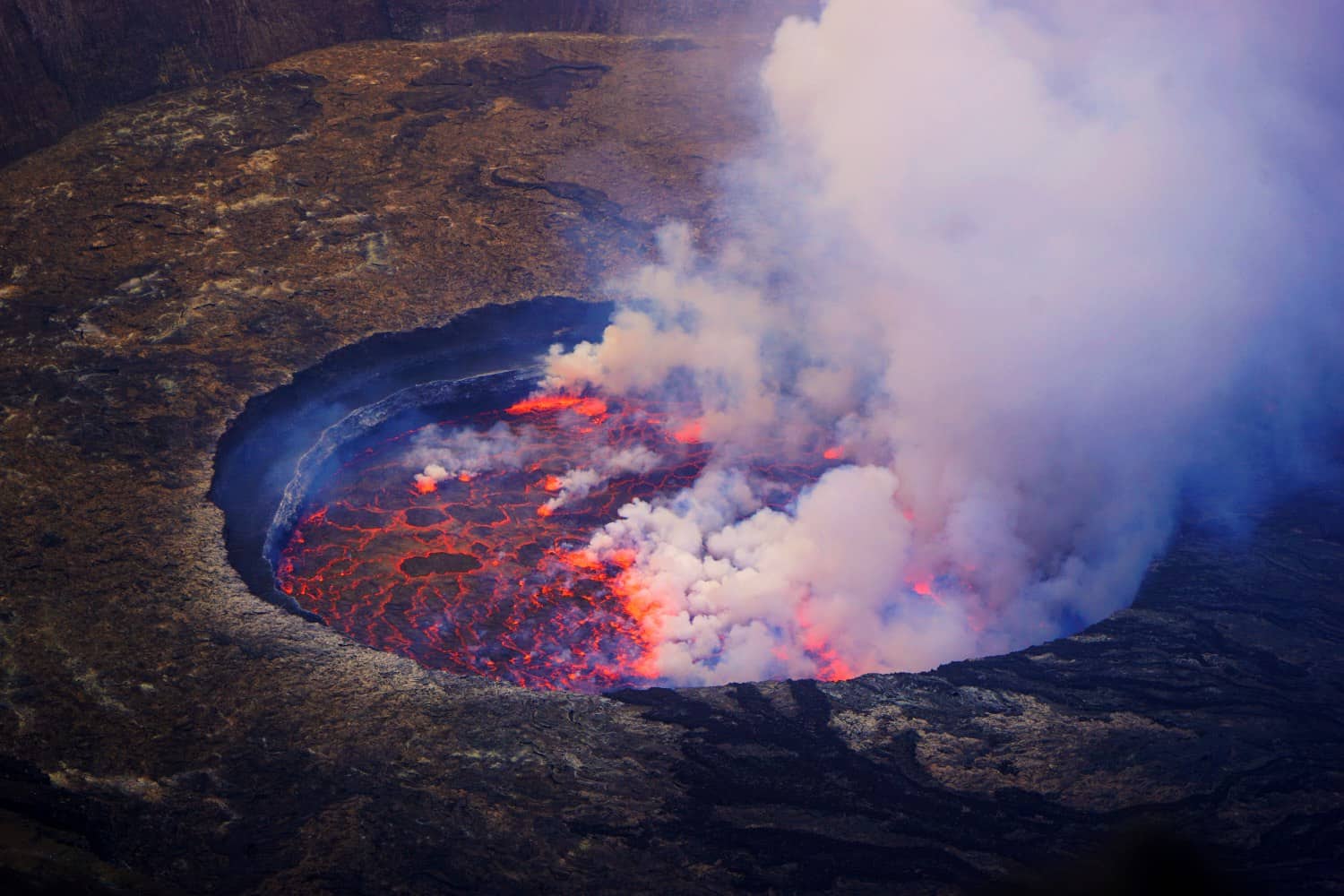
Hiking Mount Nyiragongo: The Highlight of My Life!
I’ve said it so many times, but guys, this really was the experience of my life!
If you’re wondering if it’s worth the money, I can tell you that I’m currently making plans to return next year to do it all over again, because it was simply that incredible. It was easily worth the money!
So if you’re on the fence against going, jump straight off of it and on to Virunga’s website.
I promise it’ll be one of the best things you ever do.
Does climbing Mount Nyiragongo sound like something you’d be up for doing one day?
Read More About The DRC:
🇨🇩 Gorilla Trekking in the Democratic Republic of the Congo





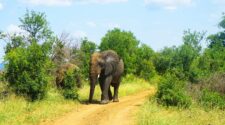
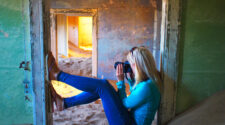
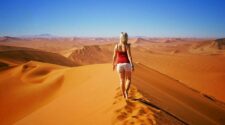
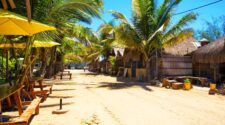
Wow, this is definitely something to go on a bucket list! I’ve been pretty jaded reading travel blogs lately…thanks for providing a real adventure story!
That means a lot to me, Henry! Glad you enjoyed the read :-)
You are pretty bad ass! That sounds like a very tricky hike, plus the fact that it’s located in the DRC. I think I’d like to visit once the situation improves a bit there :-) I’m a little bit of a scaredy-cat
Oh, thank you! I don’t often feel badass :-)
Wow, it looks adventure… amazing place to visit in this earth… thanks a lot for sharing :)
No problem! It was definitely an adventurous experience :-)
Amazing! What a life experience!
:-) Easily the best thing I’ve ever done!
Definitely a unique experience! I hiked to a boiling lake in Dominica which was very cool but this looks even cooler. Definitely still pricy but it will go on my travel list for when I have more money along with the Galapagos and the Antarctic boat from NZ. Why didn’t you use the same shoes for your Hadrian’s Wall hike? It sounds like they worked well for this hike
I did use the same shoes! They were perfect for this hike.
This looks and sounds SO epic, but I won’t lie – hearing multiple people say it’s the hardest hike they’ve ever done does NOT sell me on it. I’m an awful hiker even when I’m not at altitude, so add in the altitude and the steep ascent, and I’m not sure it’s something I ever want to do! But I did love reading about your experience and seeing those awesome photos!
Yeah, haha, it was definitely the hardest hike I’ve done, but at the same time, it sort of wasn’t as hard as I was expecting it to be. I expected it to kill me, but it wasn’t that bad.
But on your last post, you posted a terrifying border crossing experience. Could you clarify this? I would LOVE to do both.
It was nothing to do with a border crossing! After climbing the volcano, I travelled to Tchegera Island in the middle of Lake Kivu, and when I transferred from there back to Goma, my transport was late picking me up from the port.
wow this sounds so incredible! I would love to do this one day. Really helpful info on how to actually accomplish it because just knowing it is in the DRC would probably scare me away completely, so it is good to see that it is safe and easy to arrange!
Yeah, Virunga National Park is a small sanctuary in a very dangerous country, and I felt totally fine there! Highly recommend visiting if you get a chance :-)
What an amazing experience, I’d love to do that one day! Though I’d probably just skip that toilet and pee outside.
Right?! I should have done that too.
I am absolutly in love with this place and would love to make my way there, however I am worried about not being able to finish the hike… Did you find it more difficult than the tongariro crossing in NZ? X
Yes, definitely! You know that bit near the half-way point of the Tongariro where you have to climb straight up through all the loose gravel? It’s a bit like that but all the way to the top. It’s tough just because it’s essentially a straight line to the summit with no switchbacks and few flat bits. But that doesn’t mean you won’t make it to the top! Just head to the gym and use the stairmaster non-stop for the few months before you leave. And like I said in the post, a 72 year old man made it to the top in my group, so if he can do it, you can!
Wow! Those photos looking down into the lava lake are totally surreal! This is definitely something I’m adding to my bucket list :-)
Out of interest, what’s the maximum altitude you hike to? As I spent a lot of time in Peru and Bolivia a few years ago (so I was exposed to high altitude levels a lot), and I found that I was fine up to 4000 metres but above that I really struggled. Chewing coca leaves helped a lot but the problem is they’re illegal outside of South America!
Yeah, I was researching so many anti-altitude sickness tricks, but couldn’t get any of them in Portugal, so made do with pins and needles in my face from Diamox. It’s 3,500 metres at the top, so you’d probably be fine!
These photos are really great. you must have felt so much excitement watching from so close distance.
Excitement, exhilaration, in awe, nervous… :-)
I don’t believe I’ve seen a lava lake photo before in my life! Well done.
Hopefully you’ll get to see it in person one day, too!
Wow! this seems like the most adventurous places to experience and you seem to be one of the coolest person to visit the Lava Lake. Hatts off to your perseverance. Cheers!
And I agree, the toilet is really the worst toilet ever… :-P
Haha, thank you!
Weren’t you scared at any point? Of an eruption or being murdered or…?
Fun fact: the volcano actually erupts sideways so when you’re at the summit, you’re in one of the safest places if there was an eruption. And I didn’t really worry about rebel groups, because why would they climb a volcano to kill some tourists? If they wanted to kill anyone, there are far more accessible people in the country. So no, I felt super safe!
I think every commenter has said Wow to this experience, but there’s no other word for it, is there? Thank you so much for posting about this Lauren. Just found some cheap flights to Rwanda and now I’m planning my own trip to Virunga.
Oh wow! Haha. Wow to your comment as well, I guess. Hope you have an incredible time there, Samantha!
I’ve been looking at volcano treks and came across this page. You’re experience sounds amazing. I’ve been planning several trips and this now one of them. Thanks for all the info.
Yay! Hope you make it there, Nicholas :-)
When I read the post for the first time I was so excited to read about your hiking and I excited I did get. It’s amazing and the photos are unbelievable, definitely worth the hike and the gym mat and that horrendous “bathroom”. Thank you for the tips and sharing your experience with us!
I’ll never forget that bathroom! But it was totally worth it, you’re right :-)
Wow, just wow! I’ve never seen anything like this and have never heard of anyone entering the Congo before, let alone as a woman and alone. Very cool experience and gives me hope that I may be able to see something like this in my lifetime.
I hope you get to go, Harlem! It really didn’t feel that scary to be there alone and as a woman — mostly because I found it easy to make friends with people in my tour group, so always had other people to hang out with. And I trusted Virunga’s amazing rangers to keep me safe from harm.
Great post Lauren. Extremely comprehensive and honest and I also admit I couldn’t help myself from clicking through to your toilet post!
I spent most of last month reading travel books on the DRC and Congo-Brazzaville (Tim Butcher, Jeffrey Tayler, Phil Harwood and Redmond O’Hanlon) so was intrigued and then mightily impressed to see your post. I’ve never thought seriously about visiting the DRC despite my interest in the place but your pictures and descriptions certainly makes me want to try this one day.
Thanks for sharing.
Amazing pics of Lava lake. How close were you to it? Could you feel the heat? Thanks for sharing this experience. Great post.
The lake is actually 700 metres below the summit, so you weren’t actually too close. You could feel a little bit of the heat but definitely not enough for it to keep you warm or anything!
I have never seen anything like this. Wow! This looks so fun – must have been an icnredibel experience.
It was life changing!
Wow, adventurous travel experience – I’ve never seen an active volcano before. Now I’m looking where I can in the world.
Nyiragongo is the world’s most accessible lava lake, but in terms of active volcanoes, Hawaii and Vanuatu are great destinations to check out!
It is unlikely that I’ll ever make this climb (or go the DRC, as sad as that is), but if I ever do, I’ll make darn sure there is a picture of me next to the lava lake. It’s stunning and unlike anything I’ve ever seen.
You are SO adventurous and pretty darn badass!
I wish I had photos of me with the lava lake during the day! I was so spellbound by the volcano that I didn’t care about taking photos of myself, but regret it now.
Amazing pics of the lava lake. Would love to visit one day.
I hope you get there, Mara! It’s totally worth the effort and expense.
you really did a good job
Ha, thanks!
Had a buddy that just did this hike this summer. I hope to be over to East Africa and follow your tips next summer break. Thanks for breaking it down for us!
No problem! Hope you make it there, Brian. It’s an incredible experience!
Great summary, thanks for all the detail! Quick question: did Rwanda let you back in on the same visa, or did you have to apply for another one? Thanks!
You need to get a new one when you pass back through, unfortunately. But you may be able to get one on arrival, or apply for a double entry before you arrive.
Love this blog! Lot of great information!
I’m heading to Congo next week and I’m going to try to hike this volcano! It will be raining season and it is good to hear your shoes were the best, I have the same shoes :-)
Only worried a little about the toilets now…
Amazing! I’m jealous :-) You’ll have the best time ever, even with the dodgy toilets!
Wow. First of all, congratulations for making it all the way up! And secondly, thank you for putting together such a detailed blog post of your experience. I have just come back from Erta Ale in Ethiopia and this was my next challenge, but I struggled so much on Erta Ale I wasn’t sure I would attempt this one. Your post is halfway there to convincing me I can! Great photography! I can identify with not taking pictures of yourself because I felt the same way, and now am like why, why!
Thanks so much, Harpreet! It’s a tough climb, but the guides and porters are super-helpful and motivating, and everyone in our group made it to the top. There was even a guy in his 70s who managed to make it! If you spent a few months training by walking up hills or strengthening your leg muscles, I think you’d be able to succeed!
I have organized my hike with the park in a few weeks (also as a solo female) and stumbled across your page. Great review and great details! You really pumped me up…I live in Tanzania and now wish I had changed my visa dates for sooner so I could go sooner! Thanks for sharing! Cheers~
I’m so happy to hear that, Kayla! You’re going to have the best time ever there! :-)
Thanks for the great detail – amazing experience. We are so interested in this volcano climb, but have decided to postpone. We were doing it during our visit to Uganda 5 years ago but decided it would be better if we add this experience to a future Rwanda visit.
If you are interested in volcanoes do Stromboli in Sicily. An amazing volcano with great lava ‘shows’. We went 3 years ago and never forget the show of lava we saw there. Also the climb is not as difficult as Nyiragongo, elevation is about 700m. I assume you had to climb approximately 1400m for nyiragongo, starting from 2000m above sea level.
Well done and thank you for sharing your experience with us.
It’s definitely on my list! Hopefully I’ll get there soon, and hopefully you’ll climb Nyiragongo, too!
This is the best travel blog ! I travel and I am a journalist so I am rather hard on judgment.. You write so well and describe everything and the reader feels as if being you. Thank you!
Giovanna Cipriani
giovannaciprianitravel on Instagram
Thank you so much! That really does mean the world to me :-)
hey Lauren,
we are going to Virunga in October and are debating on what order to the volcano hike and the gorillas. We are thinking we should end our trip with the gorillas as a highlight (its our last stop before going back to the US) but im wondering if we shoudl save our energy for the hike ?
in your experience doing both, what do you think?
We would have the full afternoon after descending in Mikeno Lodge to rest before going on the first gorilla trek the next day.
I would suggest trekkers to always start with gorilla trekking and finish with Nyiragongo hike which is demanding. After Nyiragongo descent, it is good to not have any other activity that is not relaxing.
I definitely agree with that! My legs were like jelly after climbing Nyiragongo, so I would have struggled to hike to see the gorillas afterwards.
Nice story. Will bookmark to re-read for the time I start planning going to the DRC. And do you have any hint on getting a DRC Visa Invitation Letter without through an organized tour operator?
By the way, you forgot to pin the DRC on your “been” map! :D
I just spent some good minutes trying to know what happened next, i felt scared and excited at the same time, it was though i was on a hike too. You are indeed a badass, you just proved your own self wrong when you made it. Mount Nyiragongo is indeed the brave’s cake, how on earth would someone miss such an experience and by the way the park had been closed since 2018, but as i write just 3 days from now which will be 15th February 2019, the park will be opening again. Definitely Nyiragongo hike package is available for booking through the Virunga park website.
Oh, yes! Finally! That’s exciting :-)
Hi! I stumbled upon this after seeing that the park is back open to visitors starting this month. My fiance and I are thinking of going in September for part of our honeymoon. Naturally, since the park closed because of what happened with two tourists, their driver, and their guide, people think we’re crazy (why not just do Rwanda or Uganda?) and we keep second guessing ourselves. I agree that they wouldn’t have reopened unless they thought they had better security measures in place, and it does seem like they changed how they’re offering things (book directly through Virunga Park, set packages/schedules only). It’s like your tip to “not read the news” though, it’s hard to not keep wondering. Any thoughts or tips? Also, when did you finish your Nyiragongo hike? We’re thinking of catching a flight out that evening, but aren’t sure if we’d be done in time. Thank you for your great posts on DRC and helping break down stereotypes and fear about this area!
Lauren, thank you! I kept looking for blogs that highlight volcanos and so far I loved yours! Considering the budget is a great way of planning the trip as well, thanks for the tips! It’s also been my childhood dream to climb Mount Nyiragongo and you took me there, for free, 0 budget, lol. This for sure will be the highlight of my life, too, when I reach Mount Nyiragongo. Thank you and keep inspiring! <3
Hi Lauren, what time of year did you do the hike? I contacted the park and they said between July – Sept is the best time but wanted to check that with people who had actually gone.
Thanks.
I did it in June.